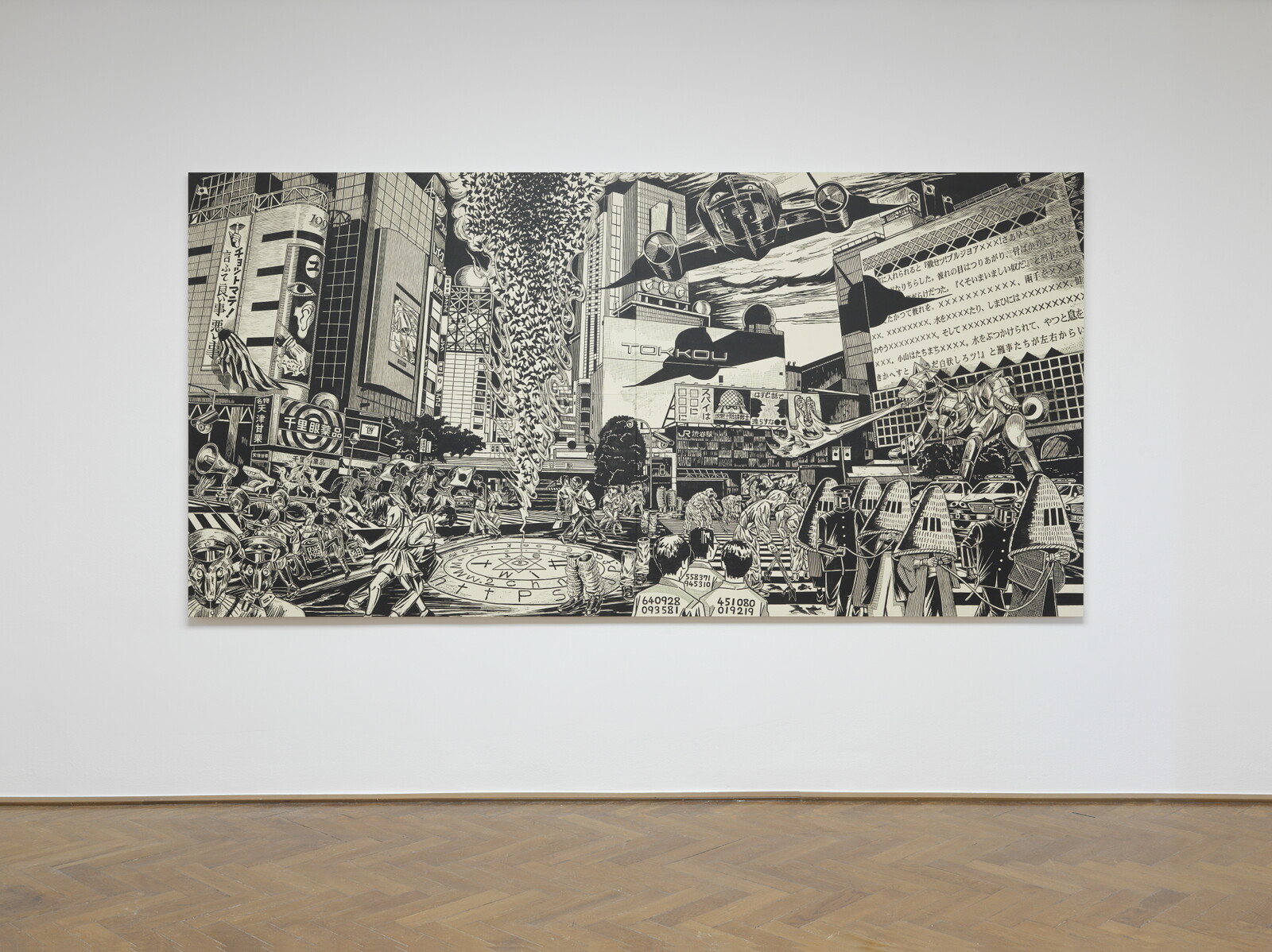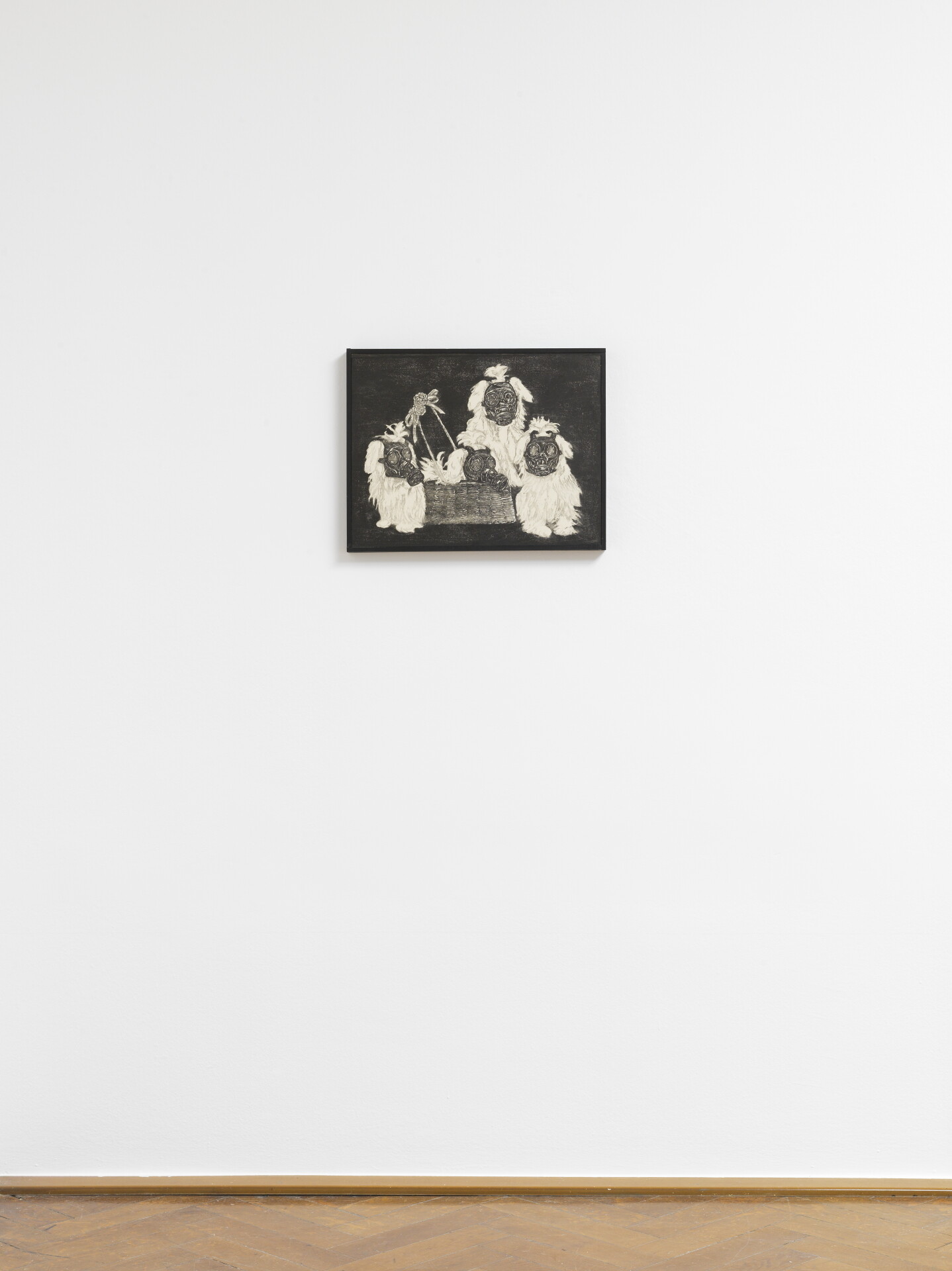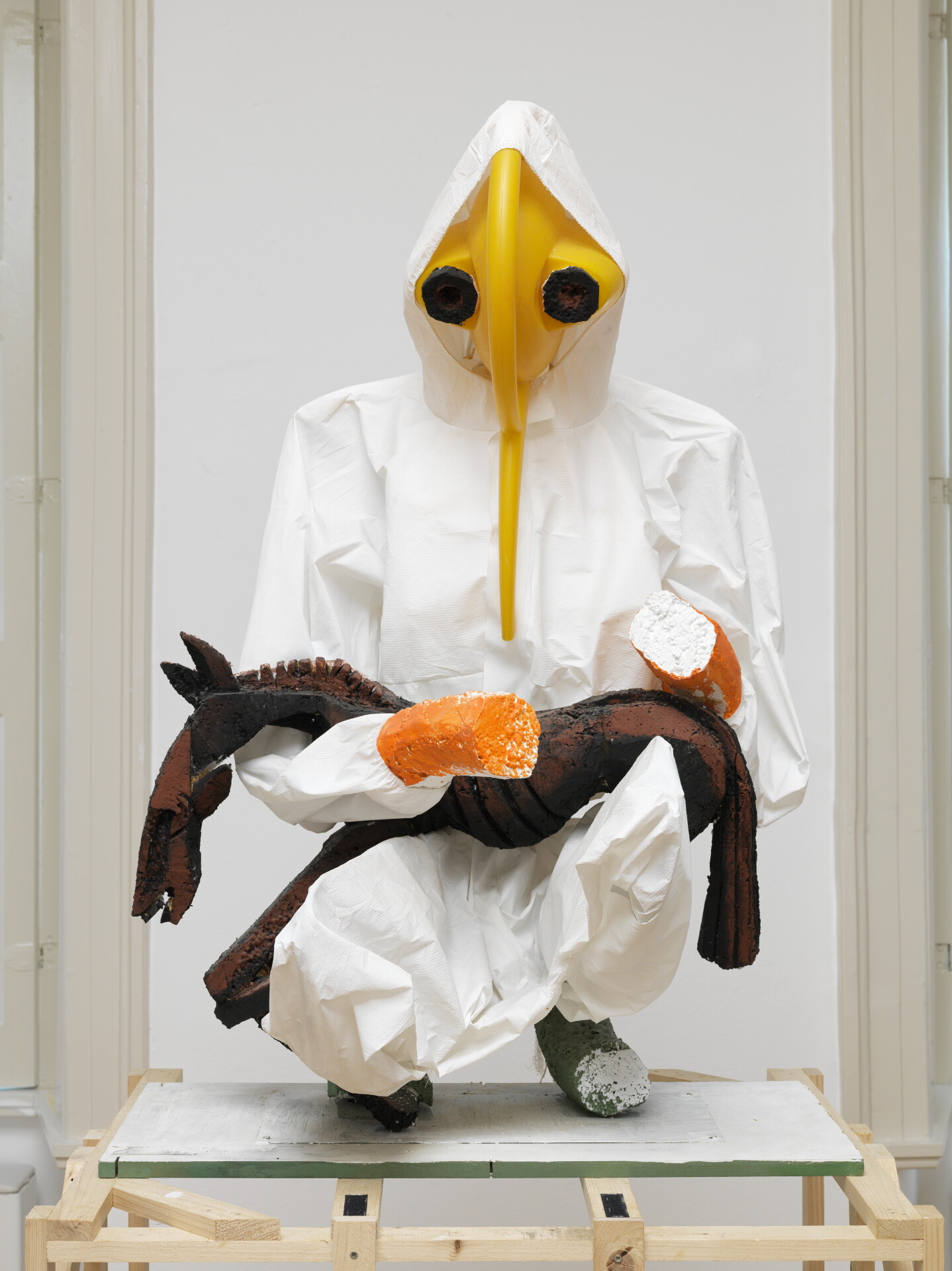Question: How do hedgehogs have sex? Answer: very carefully.
Animals are represented at every turn across the 10 venues of the Ljubljana Biennial of Graphic Arts. In the main building, the International Centre of Graphic Arts (MGLC), vitrines contain back issues of Slovenian satirical magazine Pavliha, its pages overflowing with lions and cows, lobsters and giraffes. An owl with a quill pen sinks its hooked bill into the ear of a man in a top hat. Upstairs, Sachiko Kazama’s punningly titled large-scale woodcut print Nonhuman Crossing (2013) shows a dystopian Tokyo alive with rat-faced soldiers, birds with human legs, and humans with beaks and wings. War-Pup (2005), also by Kazama, is a group portrait of fluffy white puppies wearing gas masks. “The harshest of all voices is the voice of the ass,” says an imam in Lawrence Abu Hamdan’s film The All-Hearing (2014) about Islam and “loudspeaker libertarianism” in Cairo. The biennial’s logo is a hedgehog: its jaunty form a striking marker outside every venue.
We should not be surprised. The curatorial debut of the collective Slavs and Tatars, best known for their publishing and research projects, the 33rd edition of the biennial is an exploration of satire. With its etymological roots in fullness and plenitude (satis in Latin means “enough”; satur gives us “saturation”), satire so often manifests as overflow. Across its many modes and forms, satire both buttresses and breaches the borders of reason, taste, seriousness, order, and power. That is why animals are satire’s staple: multiple mute repositories of humanity’s most egregious characteristics exaggerated to their limits and beyond.
The curatorial statement sets the tone: “With the rise of populism across the globe (not to mention reductive or revanchist forms of identity politics), there has been a vigorous debate over who constitutes ‘the people.’” The title, “Crack Up – Crack Down,” immediately alters us to satire’s ambivalent relationship to power: “crack up” suggests not just laughter but the potential for an emancipatory politics of revolution from below; “crack down” is a reminder that satire can also be a tool for repression from above.
In Galerija ZKVDS runs a reel of sketches from Slovenian satirical TV show Top lista nadrealista (1984–91). The program is ramshackle and anarchic in tone, mercilessly cruel but very funny, even for those with little knowledge of the geopolitical history. There is a sketch in the form of a gameshow in which “lucky” winners are not awarded new consumer goods (as per capitalist wish-fulfillment) but have their existing luxuries taken away. One unwilling contestant has their television forcibly removed, another their car, and one is simply sent to prison for seven years. In another sketch, a TV chef explains how best to startle your hen.
While Top lista nadrealista has been given English subtitles, the pages from Pavliha have not. By way of explanation, Slavs and Tatars describe caricature as “a visual Esperanto of sorts,” in one accompanying text. Across the biennial is speech and writing in Arabic, English, French, Russian, and Slovene. But with many these texts unglossed, only the most cosmopolitan of visitors could expect to understand everything. In the concrete poetry of Entre Tot and KRIWET’s prints, language is employed more for its formal aesthetics than its referential signification. Abu Hamdan’s Disputed Utterances (2019) presents case studies from criminal trials in which innocence or guilt rest on the conflicted interpretation of a single word or phrase. The work shows the difficulties—and consequences—of pinpointing meaning and intentionality even within one language. Such questions have long been of interest for Slav and Tatars but, for visitors, sometimes the not-knowing is simply frustrating.
While the biennial presents Pavliha as museum objects, relics from a past I do not know, an expanded approach to archival material is presented by rare book dealer Arthur Fournier and literature scholar Raphael Koenig. In MGLC Švicarija, the pair present printed materials that once belonged to German collector Eduard Fuchs, a significant influence on his friend Walter Benjamin. Adjacent to satirical works by Honoré Daumier is a twentieth-century depiction of a wolf in a suit holding, in one hand, a briefcase bursting with dollar bills, and, in the other, a handgun. Following Benjamin, the presentation also includes images from Fuchs’s collection that are now out of copyright and can be purchased, printed on canvas, via Walmart for 42 dollars. Satire lives on: “art” in the age of digital reproduction. Although the corporate behemoth is the ostensible subject of Fournier and Koenig’s satirical gesture, I wonder if there isn’t also an unconscious sneer at those who might buy such things as, urgh, mere decoration.
Some of the most striking works are by Lin May Saeed, whose usual narratives of animal liberation come to the fore. She depicts camels, pigs, horses, and deer as actors in their own right, not metaphors or analogies for human excess. Reiniger [Cleaner] (2006) is a sculpture of a human figure clad in a white medical gown and clutching a small foal in its arms. The pose comes from news footage of scientists attempting to clean oil from fur and feathers following the sinking of the Exxon Valdez oil tanker in 1989. The human face has been replaced by a watering can, its long spout reminiscent of a plague doctor’s mask. I’m intrigued by the figure’s lack of hands: Does no opposable thumbs mean no tools and therefore no technology? For it is science here, or more accurately scientism—the belief that science will always save us—that is one subject of Saeed’s satire. Her choice of Styrofoam says so much. The mere existence of this ubiquitous petrochemical product eloquently combats any faith in science as salvation (to borrow the title of a 1992 book by Mary Midgley). These days, Saeed suggests, even our most tender acts of care can never be disentangled from the mess we’ve made. Reiniger may show the foal as victim, but at least it has been freed from the satirical role so often assigned to animals.
In 2011, Slavs and Tatars published a translation of Molla Nasreddin, an early twentieth-century Azerbaijani satirical magazine named after a medieval Sufi sage and fool. Nasreddin, often pictured riding backward on a donkey, is a touchstone throughout the biennial. (Only Saeed asks us to pay more attention to the donkey.) While satire relies on the precision with which it skewers its targets, art often celebrates a multiplicity of interpretations. To exhibit one as the other is to risk compromising both. Slavs and Tatars respond by emphasizing common ground: both art and satire open spaces to speak wisdom and folly together with relative impunity, even if those spaces might always be repressed (“Crack Down”) or simply dismissed with a laugh (“Crack Up”). In “Che cos’è la poesia?” [What is poetry?] (1992), Jacques Derrida compares poetry to a hedgehog: rolled in a ball in the middle of the road and liable to get run over. Satire and art are like hedgehogs too: spiky, yes, but also vulnerable. Thanks to Slavs and Tatars, these particular hedgehogs are safe, for a time, from the oncoming traffic.

.jpg,1600)

.jpg,1600)
.jpg,1600)

.jpg,1600)
.jpg,1600)
.jpg,1600)
,%202019;%20Crack%20Up%20-%20Crack%20Down,%2033rd%20Ljubljana%20Biennial%20of%20Graphic%20Arts,%20Installation%20view,%20photo%20Jaka%20Babn%20(14).jpg,1600)
.jpg,1600)

.jpg,1600)